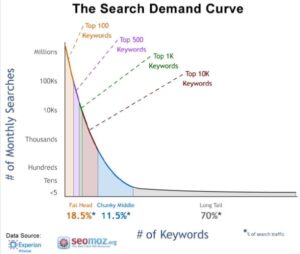Now more than ever, people are finding themselves with more time to rest, read, and reevaluate the services that they actually need or want.
Think about the last time you were looking to find a new gym. Where’s the first place you looked?
If you were thinking “Google,” you’re not alone.
In fact, 81 percent of people perform some method of online research before making a large purchase.
So what does this mean for your businesses?
It means that your audience can, and does, extensive research on services before selecting the business. When your audience is looking at your website, they’re comparing it to your competitors’.
Taking that statistic into consideration, businesses can use this opportunity to increase their visibility among their audience by following a few simple steps including using search engine optimization.
Search engine optimization, or SEO, is a huge component of how consumer behavior has and continues to evolve. SEO isn’t just about rankings—it’s about attracting the right target audience to your website.
Here Are the Five Things to Do to Get on the First Page of Google
1. Use Long-Tail Keywords
What are long-tail keywords?
Long-tail keywords are specific keyword phrases that your audience uses when they surf the net on search engines like Google.
Yes, they are longer than the keywords people generally use, but that’s not where they get their name.
 Source: Moz.com
Source: Moz.com
When we think of keywords and search volume statistics on a graph, there are popular keywords and the not so popular ones. The long-tail keywords fall under the keywords that aren’t used consistently and tend to fall along the long-tail side of a graph.
Chasing the long-tail keyword phrases can successfully target your audience.
Not only are long-tail keywords easier to keep tabs on, but they are less competitive than short-tail keywords, which allows them to be more suitable for your audience to find the service or items they want.
For example:
If someone is looking for a bed and they search for a king-size bed, they will get a large number of results that sometimes can be overwhelming. On the flip side, a person who searches “modern, wood, king-size bed” will get results that are narrowed down to a few specifics, ultimately getting them closer to purchasing that huge and in-style bed they want.
While long-tail keywords have less search volume, they provide massive value to you if your business wants to rank because they’re less competitive and provide more targeted results; Which is a long way to say that using long-tail keywords can lead to higher conversion rates.
Not only are long-tail keywords how your audience searches for information but once you master them, you can find it easier to rank among more popular search terms, helping you to dominate the competition.
Want a deeper look?
2. Make Content That Attracts
Everyone loves fresh content—Google included!
One way to do that is by updating your older and most relevant blog posts instead of spending time on making new content that doesn’t compel your audience to engage.
Updating old content doesn’t mean you have to start from scratch, as even adding a fresh image or video with a few new paragraphs can revamp that old blog. When updating old content, try to avoid changing the subheadings and blog structure because you’ll want to keep the content that is already ranking, well, ranking. The additional value that you’re adding to this content will make the post evergreen.
Changing the date doesn’t hurt either, as that can trigger your audience into thinking it’s information newly uncovered on the world wide web.
Content that is high quality will help you stand out from the competition because it’ll highlight what makes you different and how your services are more valuable. One of the ways this can be done is by writing in a conversational tone so your audience can actually understand what you’re talking about and trust you while interacting with your website.
Give your audience something worth sharing by producing content that is informative, funny, and insightful. Great content propels your audience into user-friendly experiences that exceed their expectations.
3. User Experience is Vital
User Experience, or UX, is about people. The idea behind it is to improve the overall experience of the users when they interact with your website. Ask yourself questions like:
- Is your website easy to navigate?
- Is it mobile friendly?
- Does it load fast?
- Does your webpage have a call to action?
Your audience expects your homepage to feature clear and easy navigation. One of the ways to excel at UX is by focusing on what’s important on your site and making sure your site reflects this so you can expedite the search experience. Having a concise site that solves your audience’s needs shows them that you know what they want.
Another part of user experience is webpage loading time—a.k.a. page speed. Have you ever been on a website that took forever to load? It’s frustrating for users. It’s also a big deal for Google. Page speed is considered a ranking factor among Google experts, which means easy accessibility and load time should be important to not just to your users, but to you as well.
The last thing you want your audience to do is to leave your site out of frustration. Your audience does not have time to wait, and a site taking forever to load can be the deciding factor in them selecting your services or going elsewhere.
Remember, part of your job is to guide your audience to the benefits of your services. While on that journey, ensuring that their interactions are easy can lead to customer retention, recommendations, and satisfaction.
4. Use Backlinks
Backlinks are essential to SEO because they help build your website’s domain authority and are one of Google’s most powerful ranking signals. If used correctly, backlinks can help you rank in results at a higher level.
One of the ways you can use a backlink is by connecting hyperlinks from other sites to yours, allowing you to build trust with your audience through the quality content you outsource them to. Connecting hyperlinks is significant because the backlinks then allow your audience to discover new pages and additional content.
Two easy link building strategies with concise strategies are niche directories and unlinked brand mentions. Look for mentions of your business on published sites that do not provide a link back to your website, and request a connection.
A really helpful tool to make your unlinked mention search easier is Google Alerts. You can track your name or business name so when a web page mentions your name, you’ll receive an email. Did we mention it’s free too? The more links you have from external sites, the better you look in Google’s eyes.
These backlinks give you credibility by helping users find extra information easier, and they allow you to find out how to make the information on your site relevant to your audience.
5. Schema markup
Users want value just as much as content. The content is what they’re looking for, and having a stable schema will help Google to see its usefulness.
So what’s schema markup? Schema markup is a code that tells search engines what your data means. It makes it easier for Google to crawl, organize, and display your content.
Not only do schemas provide you with the best search results possible, but adding them to your HTML will allow your content to be read more effectively by search engine crawlers.
Schemas assist in producing rich snippets, which is additional information between the URL and descriptions, to provide more informative results for users through search engines.
For instance, if you are a law firm you can display on SERP (Search Engine Results Pages) your reviews, price range, and availability in between your URL and meta description. If you are using WordPress, you can add schema plugins so you don’t have to mess around with any codes.
Get The Results You Want
Keep in mind that there’s no one size fits all decision when it comes to SEO. There is no quick solution for getting on the first page of Google. It takes work, effort, and time.
Focusing on these five elements is beneficial to audience guidance and traffic growth. Your website should incorporate all of these things to be effective and useful. UX won’t prove successful if your site doesn’t give your audience what they are even looking for.
Results don’t happen overnight, so be consistent and creative. Do quality research to come out on top.
If you want more tips like this, make sure you connect with us, because we love creative, meaningful content.

We can help you master your digital marketing strategy with CRO tips. Our team of strategists are experts at understanding you and your audience. Whether it’s setting up Google Analytics, or creating great landing pages, Wayward Kind is all about action. Ready to convert to a mindful marketing strategy? Contact us today!





